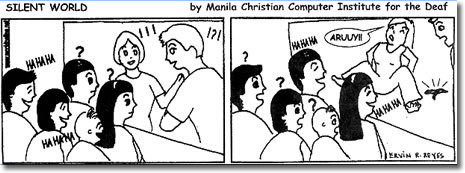 After doing an article about Deaf Laugh, I might as well talk about Deaf Humor. What makes a deaf person laugh so heartily? How can we deliver a good punchline to deaf people in order for them to “buy” our jokes?
After doing an article about Deaf Laugh, I might as well talk about Deaf Humor. What makes a deaf person laugh so heartily? How can we deliver a good punchline to deaf people in order for them to “buy” our jokes?
Always remember that a deaf person is a visual person. He/she cannot understand long winded dialogues and dramatic exchanges of verbal tones. You cannot easily pull them into watching tearjerkers and heart-wrenching scenes unless you would patiently volunteer to interpret for them. And since, they are visual, they are more of an “action” type of group. So, to choose from between Arnold’s Terminator 3: Rise of the Machines and Mandy’s A Walk to Remember, Arnold wins hands down. Of course there are some exceptions like Titanic or Ghost which is very graphic or even the famous Children of a Lesser God by Marlee Matlin, an international deaf icon.
The deaf is leaning more towards the “Leslie Nielsen” type of humor than “Billie Crystal” or “Robin Williams” type. I can even categorize them as the “Mr. Bean” type where explanation is not necessary. Rowan Atkinson is hugely popular among deaf people especially here in the Philippines. His brand of comedy strikes right through the deaf’s funny bone.
Which leads us to an assessment, deaf humor is basically a slapstick type of humor. Watching two persons clowning around draws out crispy (malutong na tawa) laugh from them or Jim Carrey falling off a cliff in “Me, Myself and Irene” than say David Schwimmer throwing punchlines to Jennifer Aniston in “Friends”. The latter would be too boring for them.
So the next time you treat a Deaf to a moviehouse and have a grand time, make sure you select a “girl-stumbling-after-stepping-into-banana-peel” genre. They would surely appreciate it. 🙂

I gather from your description here that movies (and television?) in the Philippines still have no captions or subtitles for deaf people–is that correct?
In countries where captions are widely used, it is different. Personally, I like tear-jerker movies! And I prefer movies with talking and drama over movies with violence. But I’m also lucky enough to live in the United States where finding closed captioned television programming is easy. There are only a few movies with captions in the theatre, but there are some (if you live in or near a major city). And most popular movies are captioned when they come out on DVD even if you cannot see them in the theater. So deaf people do not have to limit ourselves to any one genre or type of movie.
In the US, most deaf people don’t even go to see a movie or watch television programming unless it has captions. Many younger deaf people cannot even imagine trying to watch television without captions.
But I can remember trying to watch television and movies without captions when I was a little girl, before captioning became common. I still prefered “talking” stories even then, because that’s just the kind of story I like. I did not pick stories just because they were “visual.” But of course it was very frustrating trying to understand why the characters on the screen were crying, or angry, or happy, or surprised. I kept asking my family to explain. Sometimes that helped, but it was not really very satisfactory. When captioning technology began, it was very liberating for me to be able to watch the kind of programming I truly enjoy without depending on others to interpret.
I did know many deaf people, in “pre-captioning” days in the US, who did in fact choose movies in the way you describe here, limiting themselves to more visual “action” or slap-stick movies because those are easier to understand without captions. For people who do enjoy those kinds of movies, that choice does make sense.
wecando.wordpress.com